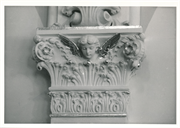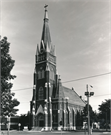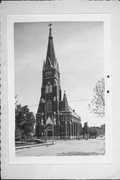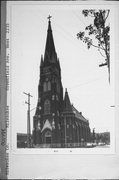Property Record
2235 W GREENFIELD AVE
Architecture and History Inventory
| Historic Name: | Christ Evangelical Lutheran Church |
|---|---|
| Other Name: | CHRIST EVANGELICAL LUTHERAN CHURCH |
| Contributing: | |
| Reference Number: | 11499 |
| Location (Address): | 2235 W GREENFIELD AVE |
|---|---|
| County: | Milwaukee |
| City: | Milwaukee |
| Township/Village: | |
| Unincorporated Community: | |
| Town: | |
| Range: | |
| Direction: | |
| Section: | |
| Quarter Section: | |
| Quarter/Quarter Section: |
| Year Built: | 1901 |
|---|---|
| Additions: | |
| Survey Date: | 1985 |
| Historic Use: | house of worship |
| Architectural Style: | Early Gothic Revival |
| Structural System: | |
| Wall Material: | Brick |
| Architect: | Frederick Velguth |
| Other Buildings On Site: | |
| Demolished?: | No |
| Demolished Date: |
| National/State Register Listing Name: | Christ Evangelical Lutheran Church |
|---|---|
| National Register Listing Date: | 9/25/1987 |
| State Register Listing Date: | 1/1/1989 |
| National Register Multiple Property Name: |
| Additional Information: | A 'site file' exists for this property. It contains additional information such as correspondence, newspaper clippings, or historical information. It is a public record and may be viewed in person at the Wisconsin Historical Society, State Historic Preservation Office. Mason: William Equitz Gothic Revival church constructed of brick with stone trim. Christ Church resembles Germany’s nineteenth-century churches, such as St. Johannis in Altona (1873) and Christ Church in Eimsbuettel-Hamburg (1885). While most Gothic Revival churches in Milwaukee combined elements from various European design traditions, German-immigrant architect Frederick Velguth's design for Christ Church adheres to a Germanic Gothic Revival style. The red brick Christ Church has two short corner towers flanking a tall central tower, like Gothic Revival churches built in Germany in the 1870s and 1880s. The soaring 182-foot spire dwarfs the relatively short nave, giving the building an upswept character. At the tower base, a quatrefoil-stamped sheet-metal pediment, flanked by two elaborate sheet-metal pinnacles, ornaments the main entrance. The stained-glass window above the pediment was designed for viewing from outside, not the inside. Backlit at dusk, the window glows in rich colors. The church’s interior is elegant and restrained. From the vestibule, worshipers pass through beautifully carved Gothic wooden doors into the nave, where two identical wooden staircases reach up to the sweeping choir and organ loft. The oak woodwork seen throughout the church is highly detailed and well crafted, not surprising considering that architect Velguth began his career as a carpenter. Baroque-style plaster ornamentation accents the nave walls, garlands bedeck each pointed-arch window, and tiny cherubs peek from the foliage atop each pilaster. The nave terminates in a semi-octagonal apse with elaborate stenciling in the vaulting. Christ Church’s congregation organized in 1884 to serve the working-class German neighborhood on Milwaukee’s near south side. Until Velguth completed this building, parishioners worshiped in a frame school on the site of the present church school. While the congregation is no longer exclusively of Germanic ancestry, German-language services continued until the 1970s. |
|---|---|
| Bibliographic References: | CORNERSTONE. MILWAUKEE ETHNIC CHURCH TOUR, CITY OF MILWAUKEE DEPARTMENT OF CITY DEVELOPMENT, 1994. Building Permit Records. Buildings of Wisconsin manuscript. |
| Wisconsin Architecture and History Inventory, State Historic Preservation Office, Wisconsin Historical Society, Madison, Wisconsin |





